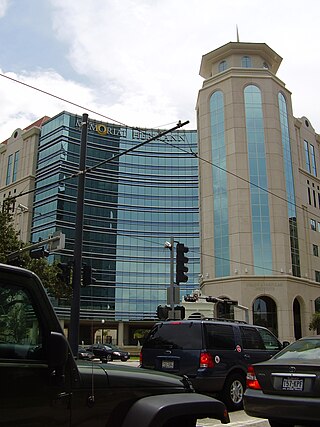
Corneal transplantation, also known as corneal grafting, is a surgical procedure where a damaged or diseased cornea is replaced by donated corneal tissue. When the entire cornea is replaced it is known as penetrating keratoplasty and when only part of the cornea is replaced it is known as lamellar keratoplasty. Keratoplasty simply means surgery to the cornea. The graft is taken from a recently deceased individual with no known diseases or other factors that may affect the chance of survival of the donated tissue or the health of the recipient.

Mass General Brigham is a not-for-profit, integrated health care system that is a national leader in medical research, teaching, and patient care. It is the largest hospital-based research enterprise in the United States, with annual funding of more than $2 billion. The system’s annual revenue was nearly $18 billion in 2022. It is also an educational institution, founded by Brigham and Women’s Hospital and Massachusetts General Hospital. The system provides clinical care through two academic hospitals, three specialty hospitals, seven community hospitals, home care services, a health insurance plan, and a robust network of specialty practices, urgent care facilities, and outpatient clinics/surgical centers. It is the largest private employer in Massachusetts. In 2023, the system reported that from 2017–2021 its overall economic impact was $53.4 billion – more than the annual state budget.
Cord blood is blood that remains in the placenta and in the attached umbilical cord after childbirth. Cord blood is collected because it contains stem cells, which can be used to treat hematopoietic and genetic disorders such as cancer. There is growing interest from cell therapeutics companies in developing genetically modified allogenic natural killer cells from umbilical cord blood as an alternative to CAR T cell therapies for rare diseases.
Eye banks recover, prepare and deliver donated eyes for cornea transplants and research. The first successful cornea transplant was performed in 1905 and the first eye bank was founded in 1944. Currently, in the United States, eye banks provide tissue for over 80,000 cornea transplants each year to treat conditions such as keratoconus and corneal scarring. In some cases, the white of the eye (sclera) is used to surgically repair recipient eyes. Unlike other organs and tissues, corneas are in adequate supply for transplants in the United States, and excess tissue is exported internationally, where there are shortages in many countries, due to greater demand and a less-developed eye banking infrastructure.
Maurice F. Rabb Jr. was an American ophthalmologist. He is widely known for his pioneering work in cornea and retinal vascular diseases.
The National Marrow Donor Program (NMDP) is a nonprofit organization founded in 1986 and based in Minneapolis, Minnesota, that operates the Be The Match Registry of volunteer hematopoietic cell donors and umbilical cord blood units in the United States.
Lions Eye Bank is the designation given to the various non-profit eye banks operated by member chapters within the Lions Clubs International service organisation. The banks store and prepare donated corneas for transplantation. Corneas may be stored for up to fourteen days before being distributed to an ophthalmic surgeon for transplantation.
European Business Aviation Association, or EBAA, is a non-profit association based in Belgium that has existed since 1977. Its more than 700 member companies span all aspects of the business aviation sector in Europe and elsewhere. The EBAA's aim is to promote excellence and professionalism among its members and to ensure that aviation is properly recognized as a vital sector of the European Economy. EBAA represents corporate operators, commercial operators, manufacturers, airports, fixed-base operators, and business aviation service providers.

OSF Saint Francis Medical Center, located in Peoria, Illinois, United States, is a teaching hospital for the University of Illinois College of Medicine at Peoria and part of the OSF Healthcare System. The center, which is the largest hospital in the Peoria metropolitan area and in central Illinois, is designated by the state of Illinois as the Level I adult and pediatric regional trauma center for a 26-county region in mid-Illinois.
The California Medical Association (CMA) is a professional organization based in California that advocates on behalf of nearly 50,000 physicians in legislative, legal, regulatory, economic, and social issues. The organization was founded in 1856 and is a member of the American Medical Association.
Air Routing International, was a worldwide provider of international trip support and corporate flight handling since 1978. Air Routing was acquired by Rockwell Collins in January 2010.

The Gift of Life Marrow Registry is a public bone marrow and blood stem cell registry headquartered in Boca Raton, Florida. Gift of Life facilitates transplants for children and adults suffering from life-threatening illnesses, including leukemia, lymphoma, other cancers and genetic diseases.

Keratoprosthesis is a surgical procedure where a diseased cornea is replaced with an artificial cornea. Traditionally, keratoprosthesis is recommended after a person has had a failure of one or more donor corneal transplants. More recently, a less invasive, non-penetrating artificial cornea has been developed which can be used in more routine cases of corneal blindness. While conventional cornea transplant uses donor tissue for transplant, an artificial cornea is used in the keratoprosthesis procedure. The surgery is performed to restore vision in patients with severely damaged cornea due to congenital birth defects, infections, injuries and burns.
Dialysis Clinic, Inc. is a nonprofit medical corporation founded in 1971 and chartered as a 501(c)(3) tax-exempt organization under IRS regulations.

Nemours Children's Hospital, Delaware is a pediatric hospital located in Wilmington, Delaware. It is operated by the Nemours Foundation, a non-profit organization created through the last will and testament of philanthropist Alfred I. du Pont by his widow Jessie Ball duPont in 1936, and dedicated to improving the health of children. Historically, it was referred to as the A. I. duPont Institute for Crippled Children or more simply, the DuPont Institute and provides pediatric specialties and subspecialties to infants, children, teens, and young adults up to age 21.

Memorial Hermann–Texas Medical Center is a nationally ranked hospital at the Texas Medical Center. It is the first hospital founded in the Texas Medical Center in Houston, Texas. Founded in 1925, it is the primary teaching hospital for McGovern Medical School and the flagship location of 13 hospitals in the Memorial Hermann Healthcare System. It is one of three certified Level I Trauma Centers in the greater Houston area. The Memorial Hermann Life Flight air ambulance service operates its fleet of helicopters from Memorial Hermann–Texas Medical Center. Pediatric care to the hospital is provided by Children's Memorial Hermann Hospital which treats infants, children, teens, and young adults age 0-21.

Sri Lanka Eye Donation Society is a non-governmental organization involved in donating human eyes and tissues for transplantation. It serves patients in need both in Sri Lanka and around the world. The society is a non-profit organization and provides the tissues free of charge, except for a small fee on processing and delivery.
SightLife is an eye bank, a non-profit organization that obtains, medically evaluates and distributes corneas donated by individuals for use in corneal transplantation, research, and education. Since 2009 it has been the leading eye bank in the United States. SightLife provides volunteer services in India, Paraguay and Nepal. In August 2022, SightLife was acquired by Lions Eye Institute. The combined company will be the largest eye bank, tissue recovery and ocular research center in the world with nearly 300 employees.
The Legacy Devers Eye Institute in Portland, Oregon, is one of the few private, non-profit centers for ophthalmological care, research, and training in the United States. The institute is affiliated with Legacy Health, a network of seven hospitals in Portland and Southwest Washington. Legacy Devers includes the Thelma and Gilbert Schnitzer Comprehensive Glaucoma Center.

A corneal button is a replacement cornea to be transplanted in the place of a damaged, diseased or opacified cornea, normally approximately 8.5–9.0mm in diameter. It is used in a corneal transplantation procedure whereby the whole, or part, of a cornea is replaced. The donor tissue can now be held for days to even weeks of the donor's death and is normally a small, rounded shape. The main use of the corneal button is during procedures where the entirety of the cornea needs to be replaced, also known as penetrating keratoplasty.








